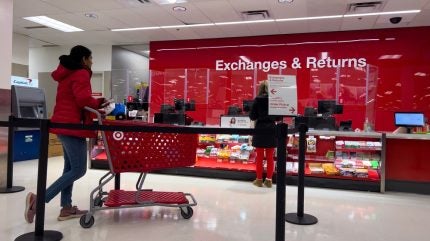
Retailers in the United States anticipate that nearly $850bn worth of merchandise will be returned this year, according to the 2025 Retail Returns Landscape report released by the National Retail Federation (NRF) and Happy Returns, a UPS company.
The projected return rate of 15.8% of total annual sales is slightly lower than last year’s 16.9%, when returns reached $890 billion.

Discover B2B Marketing That Performs
Combine business intelligence and editorial excellence to reach engaged professionals across 36 leading media platforms.
Katherine Cullen, NRF Vice President of Industry and Consumer Insights, highlighted that returns are increasingly viewed as a key part of the shopping experience rather than the conclusion of a purchase.
“Retailers recognise the importance of the returns process in building customer loyalty and meeting evolving consumer expectations,” she said.
Rising online returns and generational trends
Online shopping continues to drive higher return rates, with an estimated 19.3% of e-commerce sales expected to be returned in 2025.
Younger consumers, particularly those aged 18 to 30, are returning online purchases more frequently than any other generation, averaging 7.7 returns over the past year.

US Tariffs are shifting - will you react or anticipate?
Don’t let policy changes catch you off guard. Stay proactive with real-time data and expert analysis.
By GlobalDataConsumer expectations are also evolving. Free returns are now a decisive factor for 82% of shoppers, up from 76% in 2024, while 76% prioritise options that offer instant refunds or exchanges.
Poor experiences can have lasting effects, with 71% of shoppers reporting they would be less likely to buy from a retailer again following an unsatisfactory return, and four in five indicating they would share the experience with friends or family.
Operational pressures and return costs
Retailers face mounting operational pressures as they balance customer demands with rising costs.
Surveyed merchants identified increased operational expenses (40%), higher carrier shipping costs (40%), and economic uncertainty, including tariffs (33%), as leading reasons for charging fees on returns.
Nearly two-thirds (64%) plan to update their returns processes in the next six months to improve efficiency and reduce costs.
Return fraud remains a significant concern, with 9% of returns found to be fraudulent. Common tactics include overstating the quantity of returns (71%), sending empty boxes (65%), and submitting counterfeit items (64%).
Technology, including artificial intelligence, is increasingly used to detect and prevent fraudulent activity, with 85% of retailers reporting adoption.
Strategies for holiday returns and consumer behaviour
Retailers expect 17% of holiday merchandise to be returned, a figure consistent with previous years. Strategies to manage this include partnering with third-party logistics providers (49%), hiring seasonal staff for returns (43%), and extending return windows (37%).
Younger consumers continue to engage in returns practices that can increase costs, such as “wardrobing,” “bracketing,” or returning items in empty boxes.
Close to 45% of shoppers believe it is acceptable to bend the truth when making a return, particularly if dissatisfied with a product.
David Sobie, co-founder and CEO of Happy Returns, emphasised the strategic importance of modernising reverse logistics.
“Return policies influence how younger consumers shop from the outset. Retailers must enhance customer satisfaction, reduce fraud, and protect their operations to remain competitive amid rising return rates,” he said.



